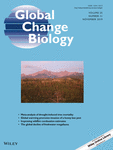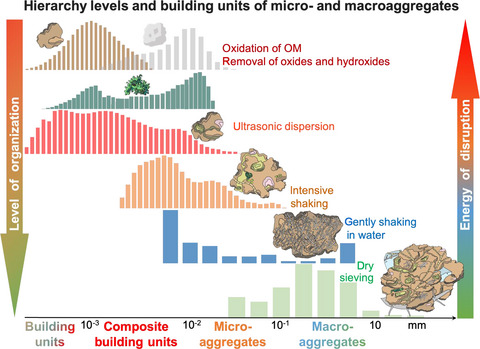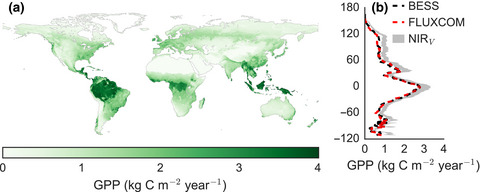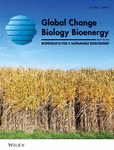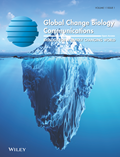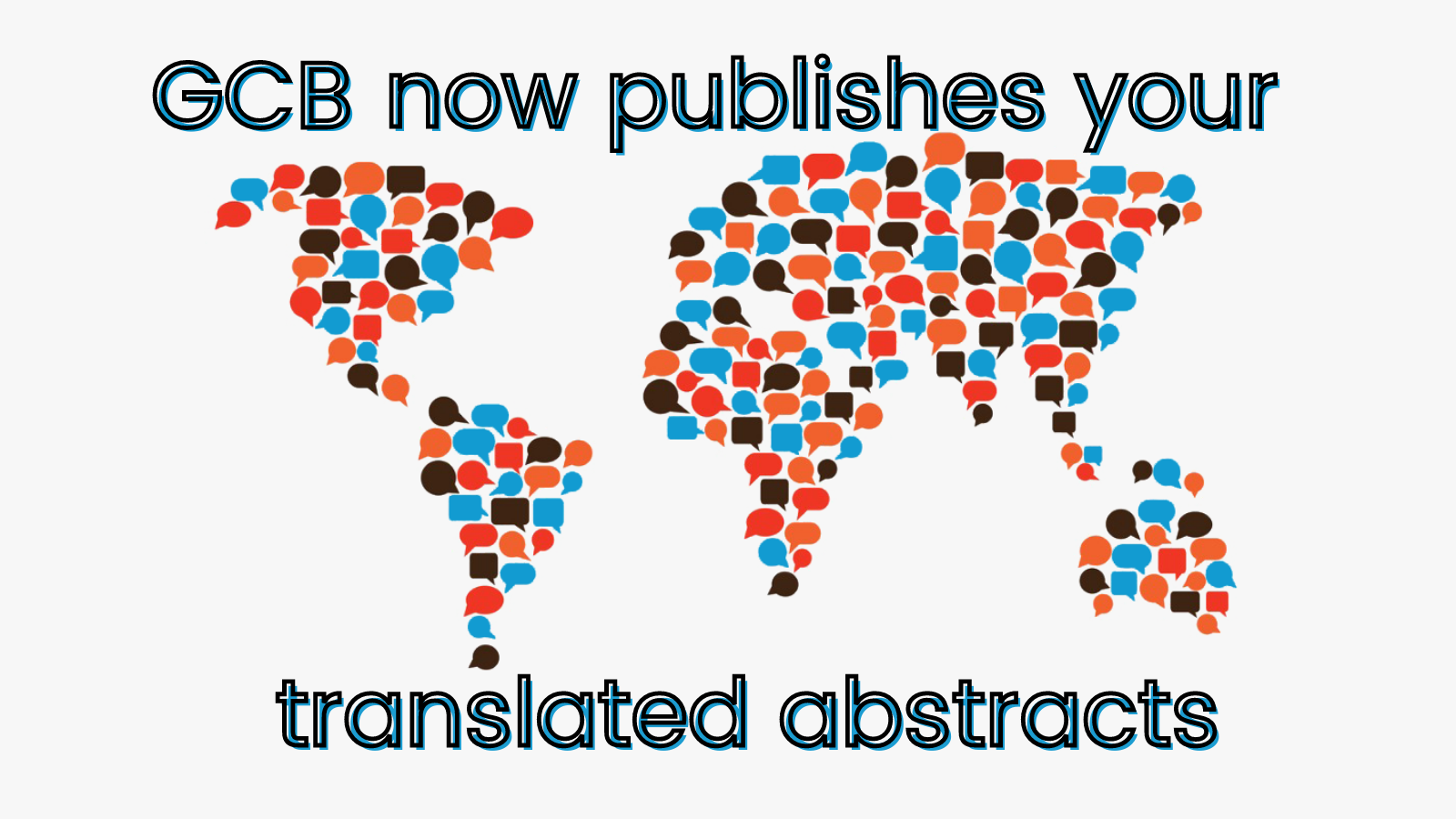Journal list menu
Export Citations
Download PDFs
ISSUE INFORMATION
LETTERS TO THE EDITOR
Biological interactions: The overlooked aspects of marine climate change refugia
- Pages: 3571-3573
- First Published: 25 June 2019
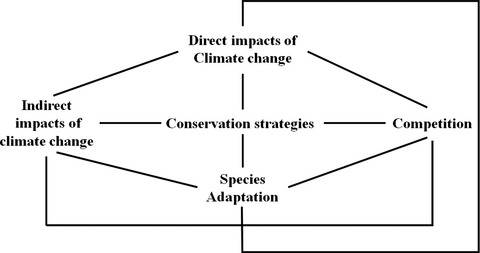
This article emphasizes on biological interactions as an important overlooked criterion to better assess the chance of target marine species in potential refugia to survive climate change. It proposes future climate change refugia studies must consider the reciprocal interactions among climate change, biological factor, and conservation strategies.
OPINION
Quantitative assessment of microbial necromass contribution to soil organic matter
- Pages: 3578-3590
- First Published: 31 July 2019
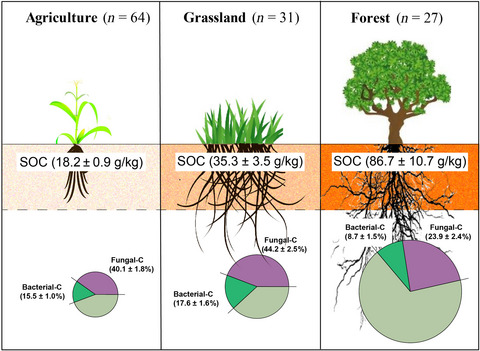
We reprocessed existing amino sugar data, published between 1996 and 2018 from global agricultural, grassland, and forest ecosystems in temperate zones, by scaling them up to microbial necromass carbon. On average, microbial necromass abundance increased in the order agricultural < grassland < forest, while its contribution to soil organic carbon (SOC) storage was lowest in the forest ecosystem. Fungal necromass abundance and its contribution to SOC were consistently higher than bacterial necromass. Microbial necromass can make up more than half of SOC pool, suggesting the need to understand microbial necromass conservation in the context of soil management and climate change mitigation.
RESEARCH REVIEWS
Cryptic phenology in plants: Case studies, implications, and recommendations
- Pages: 3591-3608
- First Published: 25 July 2019
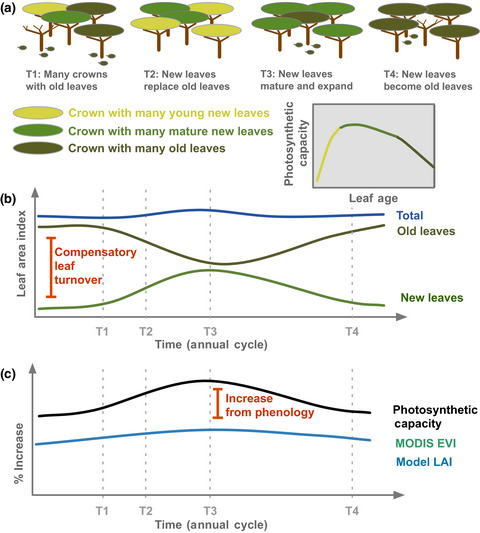
Plant phenology offers insight into plant biology and plant-mediated ecosystem processes. However, many plant phenological processes are “cryptic” in that they are hidden (e.g., root production) or undistinguishable based on common measurements at typical scales of examination (e.g., leaf turnover in evergreen forests). Here, we offer a framework for cryptic phenology and synthesize literature with a focus on whether terrestrial biosphere models currently capture cryptic phenology. We illustrate how capturing cryptic phenological processes can advance scientific understanding and vegetation modeling with two case studies: wood phenology in a temperate deciduous forest and leaf phenology in tropical evergreen forests of Amazonia.
Estimating aboveground net biomass change for tropical and subtropical forests: Refinement of IPCC default rates using forest plot data
- Pages: 3609-3624
- First Published: 16 July 2019
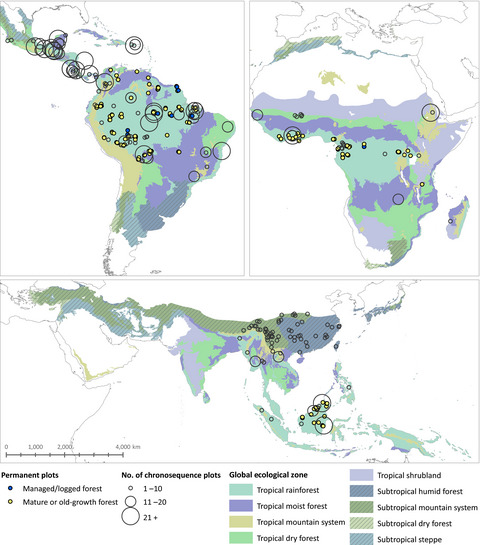
As countries advance in greenhouse gas (GHG) accounting for climate change mitigation, consistent estimates of aboveground biomass change (∆AGB) in natural forests are needed. Countries with limited forest monitoring capabilities in the (sub)tropics rely on the 2006 IPCC guidelines for default ∆AGB rates. This study provides refined default ∆AGB rate estimates based on forest plot data in younger secondary forests, older secondary forests and old-growth forests, located in 42 countries across (sub)tropical ecozones. These new estimates contribute towards the 2019 IPCC Refinement and can be used for large-scale GHG accounting by governmental bodies, nongovernmental organizations and in scientific research.
The functional role of temperate forest understorey vegetation in a changing world
- Pages: 3625-3641
- First Published: 13 July 2019
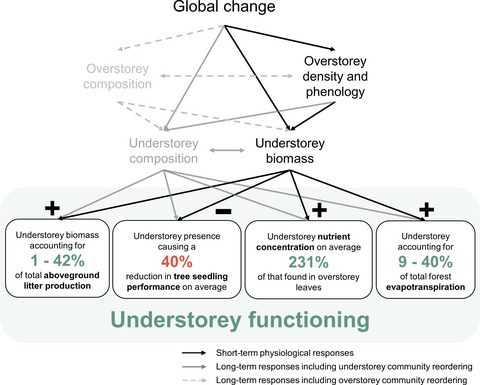
The understorey in temperate forests is an important biodiversity reservoir that can influence ecosystem functioning in multiple ways. We here compiled studies that quantify the relative importance of the understorey for temperate forest functioning, focussing on litter production, tree regeneration, nutrient cycling and evapotranspiration and show that the understorey's contribution to temperate forest functioning is significant but varies depending on the ecosystem function and the environmental context. Our review also shows that studies that quantify both overstorey and understorey functioning are still scarce, providing little data to forecast changes in the understorey's relative importance under global change.
PRIMARY RESEARCH ARTICLES
Global warming promotes biological invasion of a honey bee pest
- Pages: 3642-3655
- First Published: 08 August 2019
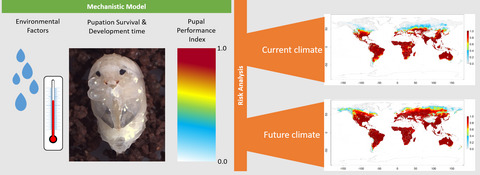
The small hive beetle (SHB) is an invasive honey bee pest. We investigated the potential distribution and impact of the small have beetle based on its ability to pupate under current and future climate conditions. The results show many areas yet uninvaded, as suitable for pupation, suggesting considerable invasion risk. Future scenarios of global warming project a vehement increase in climatic suitability for SHBs to pupate. Our study shows that climate change, and global warming in particular, can promote the impact of a honey bee pest on a global scale.
Spatial heterogeneity in climate change effects decouples the long-term dynamics of wild reindeer populations in the high Arctic
- Pages: 3656-3668
- First Published: 21 August 2019
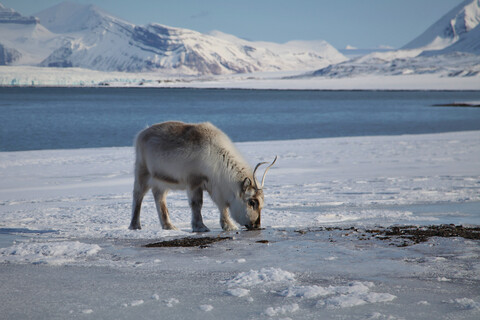
Spatially autocorrelated weather and climate may cause population co-fluctuations over large distances. We show that increasingly frequent rain-on-snow (ROS) and icing events in winter synchronize the annual dynamics of Svalbard reindeer populations, while, paradoxically, spatial variation in ROS trends and density-dependent weather effects cause diverging local population trajectories in the long run. Such decoupling of population dynamics increases species viability under a rapidly warming high-Arctic climate.
Flexibility in a changing arctic food web: Can rough-legged buzzards cope with changing small rodent communities?
- Pages: 3669-3679
- First Published: 07 August 2019
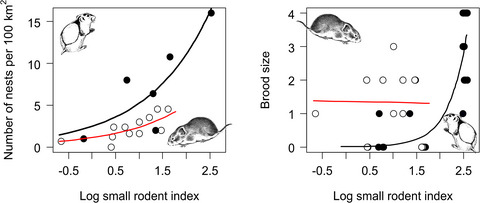
Indirect effects of climate change are often mediated by trophic interactions and consequences for individual species depend on how they are tied into the local food web. Here we show that the breeding density of an arctic bird of prey decreased when small rodents, its main prey, experienced a shift from high-amplitude cycles to moderate fluctuations paralleled with a change in species composition toward less lemmings and more voles. At the same time, however, the birds still breeding had on average larger broods, suggesting that the population adapted to a certain degree to the changes in the major resource.
Northward range expansion in spring-staging barnacle geese is a response to climate change and population growth, mediated by individual experience
- Pages: 3680-3693
- First Published: 02 September 2019
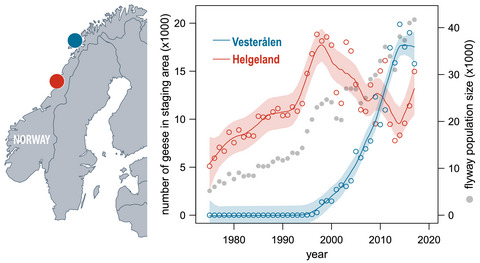
A long-term study on spring-migrating barnacle geese (Branta leucopsis) from the Svalbard-breeding population demonstrates that geese recently have colonized a new, more northerly staging area (Vesterålen, Norway). In this northern area, food conditions have improved due to a warmer climate. The population has doubled in size during the past 25 years, and we argue that this is associated with the northerly area becoming suitable as a foraging ground. The colonization of the northerly area was set in motion by younger individuals. In later years, older birds followed, and increasingly chose to switch to the northerly area.
Invasive plants negatively impact native, but not exotic, animals
- Pages: 3694-3705
- First Published: 07 August 2019
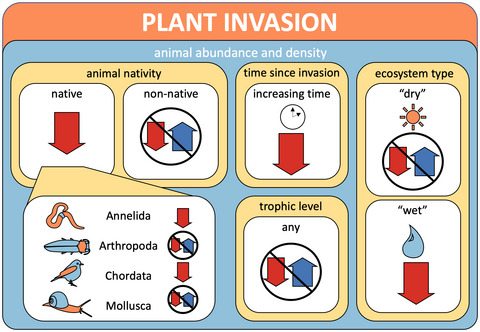
Despite our growing understanding of the impacts of invasive plants on ecosystem structure and function, important gaps remain, including whether resident native and exotic species respond differently to plant invasion. We found that invasive plants reduced the abundance of native, but not exotic, animals, though this varied by animal phyla, with invasive plants reducing the abundance of native annelids and chordates, but not mollusks or arthropods. We provide an important first insight into how native and exotic species respond differently to plant invasion, the consequences of which may facilitate cascading trophic disruptions further exacerbating the impacts of invasive plants.
Weakened growth of cropland-N2O emissions in China associated with nationwide policy interventions
- Pages: 3706-3719
- First Published: 24 June 2019
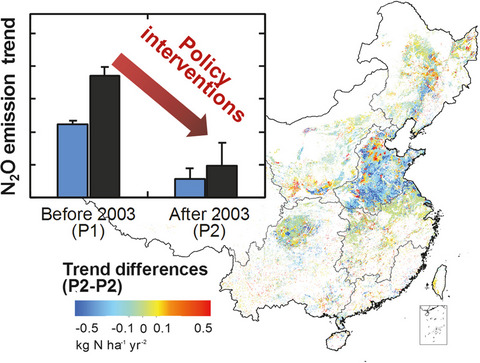
New data-driven estimates of cropland-nitrous oxide (N2O) emissions across China in 1990–2014 improves our understanding of their historical trends and associated drivers. The data illuminate a direct evidence of the nationwide deceleration of cropland-N2O emissions since 2003, mainly due to policy-driven reduction of nitrogen-fertilizer applied per area. These findings that challenge the traditional views about the continuous increase in cropland-N2O emissions in China, underline the potential value of local policy interventions for future projections.
Impacts of intensifying or expanding cereal cropping in sub-Saharan Africa on greenhouse gas emissions and food security
- Pages: 3720-3730
- First Published: 03 August 2019
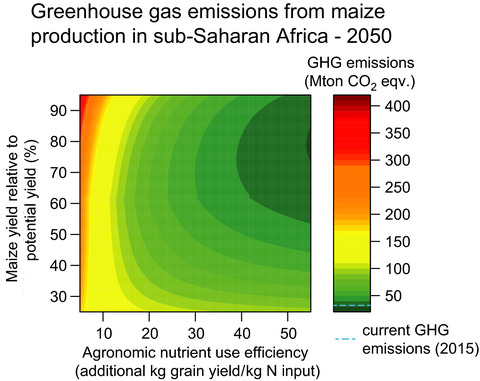
Food production in sub-Saharan Africa needs to rise steeply to keep up with food demands. Self-sufficiency can be achieved by either intensifying or expanding agricultural land. Our study provides insights into the consequences of these on greenhouse gas (GHG) emissions towards 2050. We show that GHG emissions from cereal production (including emissions from fertilizer use and land use change) will increase in all scenarios. Intensifying cereal cropping with efficient use of nutrients will lead to less GHG emissions than expanding cereal cropping into forest areas.
Terrestrial gross primary production: Using NIRV to scale from site to globe
- Pages: 3731-3740
- First Published: 14 June 2019
Largely underestimated carbon emission from land use and land cover change in the conterminous United States
- Pages: 3741-3752
- First Published: 16 July 2019

This study showed a large uncertainty in accounting carbon fluxes (Eluc) from land use and land cover change (LULCC) in the conterminous United States. We compared the Eluc from model simulations by using a commonly used global land use database (LUH2) and a US-specific, multisource harmonized land use data (YLmap). Simulation results showed that the LUH2-based LULCC data resulted in a C accumulation of 1,121.0 ± 90.9 Tg from 1980 to 2016, while YLmap-based LULCC led to a carbon source of 501.5 ± 130.8 Tg during the same period. The opposite estimates may be attributed to the aggregated land conversion signals in coarse resolution database of LUH2.
Deep soil inventories reveal that impacts of cover crops and compost on soil carbon sequestration differ in surface and subsurface soils
- Pages: 3753-3766
- First Published: 13 July 2019
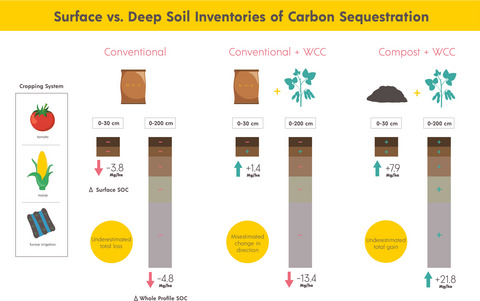
In a 19 year study in California, compost + cover crops in a maize–tomato rotation increased soil carbon by 12% to 2 m, whereas cover crops alone resulted in cumulative soil carbon losses when considering the entire 2 m profile. Reliance on synthetic inputs alone resulted in no soil carbon changes to a 2 m depth in maize–tomato, and wheat–fallow rotations showed little potential to increase soil carbon. Measuring soil carbon in only the surface would have resulted in over- and underestimates of soil carbon changes; therefore, the entire soil profile should be considered when estimating the potential for soil carbon sequestration.
Modeling the impact of liana infestation on the demography and carbon cycle of tropical forests
- Pages: 3767-3780
- First Published: 16 July 2019
Contrasting resistance and resilience to extreme drought and late spring frost in five major European tree species
- Pages: 3781-3792
- First Published: 22 August 2019
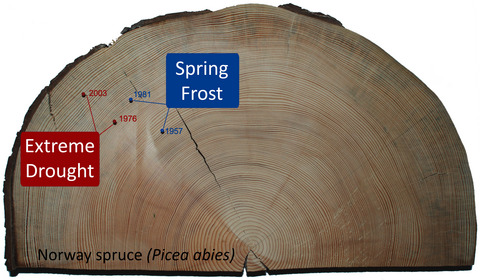
There is an urgent need to assess the specific responses of trees to both drought and spring frost to provide solid bases for decision-making regarding the selection of tree species matching the ongoing environmental change. Using tree-ring width series from 2,844 trees from 104 Swiss sites ranging from 400 to 2,200 m a.s.l. for the period 1930–2016, we found strong disparities in the species resistance and resilience to extreme droughts and spring frosts. Oak, fir, and to a lower extent beech could moderately cope with severe droughts whereas spruce and larch only poorly resist and recover after such events.
Widespread drought-induced tree mortality at dry range edges indicates that climate stress exceeds species' compensating mechanisms
- Pages: 3793-3802
- First Published: 19 July 2019
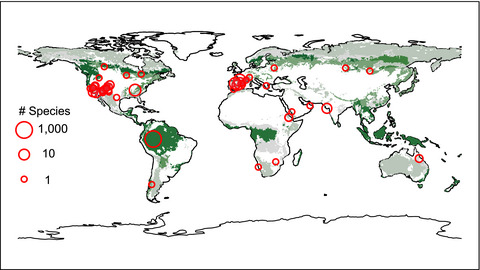
Drought-induced tree mortality is projected to increase due to climate change, yet predictions of tree mortality remain limited, in part because within-species variations in ecophysiology and ecosystem adjustments could buffer mortality in dry locations. Here, we conduct a meta-analysis of 50 studies spanning >100 woody plant species globally to quantify how populations within species vary in vulnerability to drought mortality. We find that climate stress has exceeded physiological and ecosystem-level tolerance or compensating mechanisms by triggering extensive mortality at dry range edges, providing a foundation for future mortality projections in empirical distribution and mechanistic vegetation models.
Legacies of more frequent drought in ponderosa pine across the western United States
- Pages: 3803-3816
- First Published: 03 June 2019
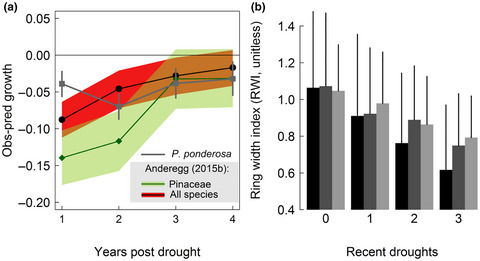
We quantified the impact of repeated or multi-year drought, that is, drought occurring during the recovery from previous drought, upon growth in ponderosa pine in the western US. Consistent with expectation, we found more droughts had greater impacts on growth, but unexpectedly, differences in responses among regions suggested regional adaptations to frequent drought. We argue considering the long memory of tree response to climate is critical.
Understanding and predicting frost-induced tropical tree mortality patterns
- Pages: 3817-3828
- First Published: 25 July 2019
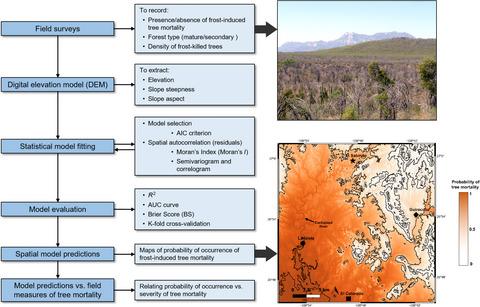
Extreme climatic and weather events are increasing in frequency and intensity across the world causing episodes of widespread tree mortality. We investigated the effects of two major local factors, topography and forest successional type, on climate-induced tropical tree mortality patterns in northwestern Mexico using an observational and modeling approach. Elevation is the main factor modulating frost effects. Holding elevation constant, the probability of frost-induced tree mortality in mature forests was twice that of secondary forests but severity showed the opposite pattern, suggesting a cautious use of occurrence probabilities of tree mortality to infer climate-driven disturbance severity.
Wildfire refugia in forests: Severe fire weather and drought mute the influence of topography and fuel age
- Pages: 3829-3843
- First Published: 18 June 2019
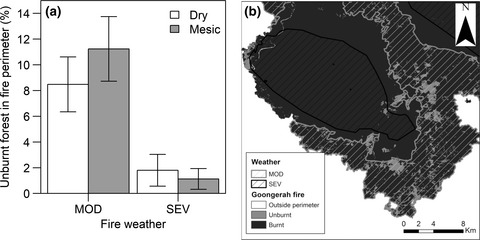
Fire refugia (i.e. unburnt patches) are important for the persistence of fire-sensitive species in forests, though the fate of fire refugia under climate change is unknown. Quantification of the relative effects of climate and landscape factors on refugia patterns across Australian temperate forests revealed that fire weather and drought override the effect of topography and fuel age on fire refugia, with less refugia being present under severe fire weather and intense drought. Climate change is likely to lead to the contraction and loss of persistent fire refugia across temperate forests of southern Australia.
Integrating anthropogenic factors into regional-scale species distribution models—A novel application in the imperiled sagebrush biome
- Pages: 3844-3858
- First Published: 10 June 2019
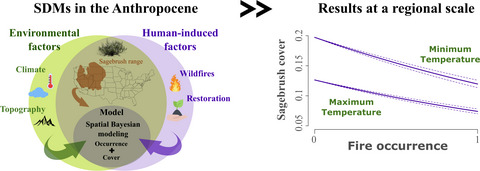
As human impact on natural processes grows, species distributions are increasingly overridden by anthropogenic influence, such as altered wildfire regimes and ecological restoration. Incorporating these anthropogenic variables into species distribution models is a research need that is complicated by the scale mismatch between regional distributions and fine-scale variation in anthropogenic impacts. Our study demonstrates how novel datasets and spatial models can resolve this challenge. We apply our modeling framework to understand the distribution of big sagebrush across the Great Basin of North America. We found that wildfire and restoration treatment history have effects that are comparable to climate and topography.
Effects of climate warming on Sphagnum photosynthesis in peatlands depend on peat moisture and species-specific anatomical traits
- Pages: 3859-3870
- First Published: 09 September 2019
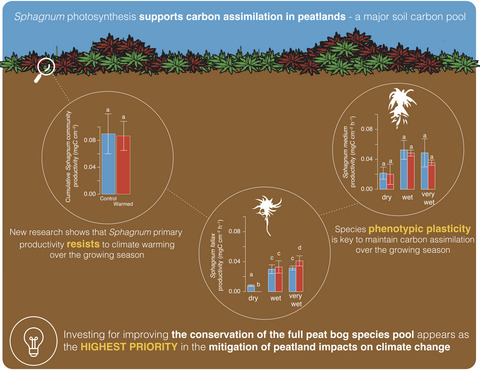
Sphagnum photosynthesis supports carbon (C) assimilation in peatlands—a major C pool. New research shows that Sphagnum primary productivity resists climate warming over the growing season. Species phenotypic plasticity is the key to maintain C assimilation under climate warming. The conservation of the full peat bog species pool appears as the chief priority in the mitigation of peatland impacts on climate change.
Network parameters quantify loss of assemblage structure in human-impacted lake ecosystems
- Pages: 3871-3882
- First Published: 25 July 2019
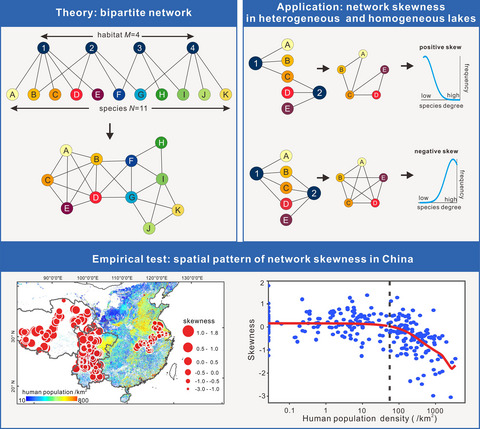
We test a new proxy for ecological network deformation caused by external stress, using diatom (algal) assemblages across China. We link species through shared habitats (top-left panel, upper part) to obtain a network of associations (top-left, lower). We argue that undisturbed lakes will have positively skewed distributions in their degree of species associations (top-right, upper), while disturbed lakes will shift towards negative skew (top-right, lower). Field data show the frequency distributions of species associations that switch from positive to negative skew across a west–east gradient of increasing disturbance (bottom panel map) linked to human population density (bottom graph).
The global decline of freshwater megafauna
- Pages: 3883-3892
- First Published: 08 August 2019
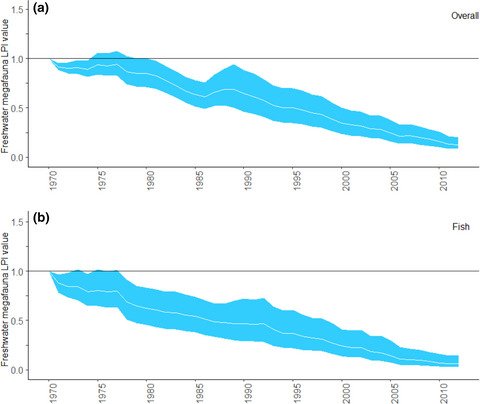
Globally, freshwater megafauna populations declined by 88% from 1970 to 2012, with the highest declines in the Indomalaya and Palearctic realms (−99% and −97%, respectively). Among taxonomic groups, mega-fishes exhibited the greatest global decline (−94%). In addition to population declines, major range contractions of freshwater megafauna have been observed, which is more pronounced in Europe than in the United States.
Pathogen exposure disrupts an organism's ability to cope with thermal stress
- Pages: 3893-3905
- First Published: 31 May 2019
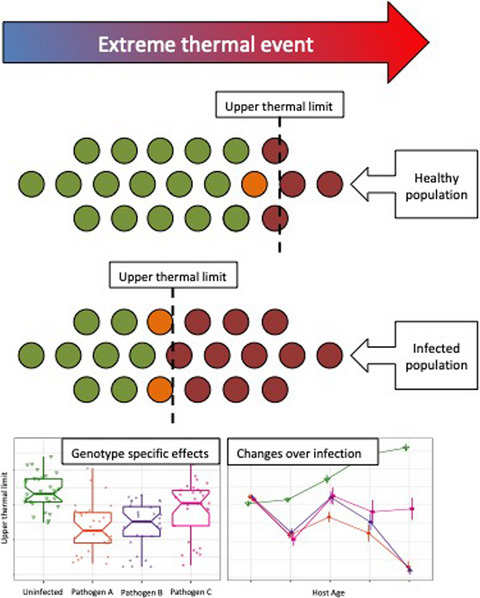
Upper thermal limits were reduced by exposure to infectious disease; and depended on the severity of infection, the type of thermal stress encountered and the specific genotype of both the host and pathogen. We observed that pathogens could reduce thermal limits at a magnitude equivalent in scale to the natural variation in thermal limits seen within species over large geographic and ecological ranges.
The brighter side of climate change: How local oceanography amplified a lobster boom in the Gulf of Maine
- Pages: 3906-3917
- First Published: 25 July 2019
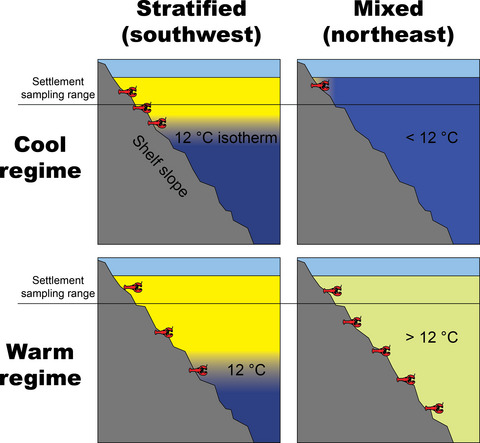
Ocean warming has rapidly expanded the amount of thermally suitable bottom habitat for settling American lobster postlarvae in the Gulf of Maine. Local oceanography, coupled with nonlinear responses to warming, may have led to a demographic expansion disproportionate to the relatively small change in bottom temperature. Habitat expansion offshore may explain population increases northeastward and decreases in inshore settlement densities.
Refugia under threat: Mass bleaching of coral assemblages in high-latitude eastern Australia
- Pages: 3918-3931
- First Published: 31 August 2019

High-latitude region has been heralded as potential climate change refugia for many species. However, our findings highlight that high-latitude coral assemblages are critically threatened by the effects of ocean warming as endemic and high-latitude specialist species are particularly prone to punctuated heat stress.
Nearshore coral growth declining on the Mesoamerican Barrier Reef System
- Pages: 3932-3945
- First Published: 27 August 2019
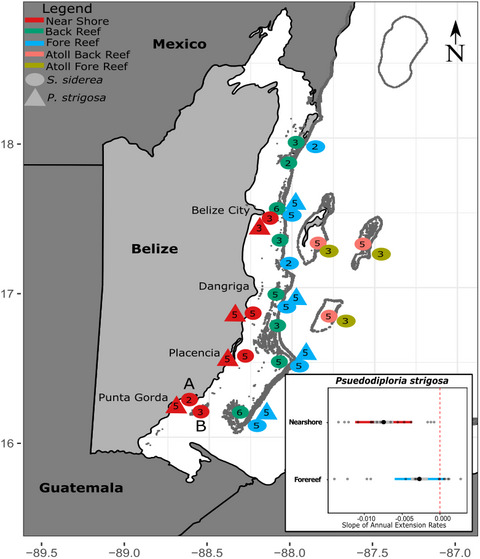
Analysis of 124 coral cores collected across the Belize Mesoamerican Barrier Reef System indicates that nearshore corals have historically grown faster than their offshore counterparts, but that growth rates of nearshore corals are in decline while offshore growth rates remain stable. For both species, individual mass coral bleaching events were correlated with low rates of skeletal extension within specific reef environments, but no single bleaching event was correlated with low skeletal extension rates across all reef environments. We postulate that the decline in skeletal extension rates for nearshore corals is driven primarily by the combined effects of long-term ocean warming and increasing exposure to higher levels of land-based anthropogenic stressors, with acute thermally induced bleaching events playing a lesser role.
Centennial decline in North Sea water clarity causes strong delay in phytoplankton bloom timing
- Pages: 3946-3953
- First Published: 23 August 2019

Predicted phytoplankton response to increased non-chlorophyll light attenuation. In this study, we present evidence suggesting a centennial increase in non-chlorophyll light-attenuating substances in the North Sea. This implies a reduction of the euphotic zone, leading to a delayed, intensified, and prolonged spring bloom. While climate warming is suggested to advance the spring bloom due to earlier shoaling of the mixed layer, it also causes browning in lakes and rivers due to increases in terrestrial greening, ultimately reducing water clarity in downstream coastal areas. These contrasting responses highlight the importance of including water transparency in analyses of phytoplankton phenology and primary production.
Trait-based climate vulnerability assessments in data-rich systems: An application to eastern Bering Sea fish and invertebrate stocks
- Pages: 3954-3971
- First Published: 17 September 2019
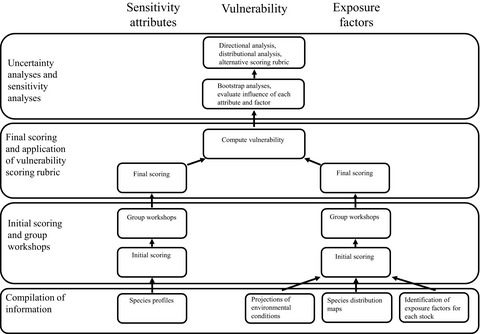
We conducted a trait-based climate vulnerability assessment for groundfish, salmon, and crab stocks in the eastern Bering Sea, a data-rich region, and leveraged existing downscaled climate projections, species distribution models, and (for some stocks) detailed biological studies. The vulnerability ranged from “low” to “moderate”; however, comparison with more detailed studies indicates that water temperature may have important effects on climate vulnerability for some stocks. We also demonstrate how several types of uncertainties (climate projections, biological, and model structure) can be analyzed and communicated, including bootstrapping of the results.
Fish communities diverge in species but converge in traits over three decades of warming
- Pages: 3972-3984
- First Published: 03 August 2019
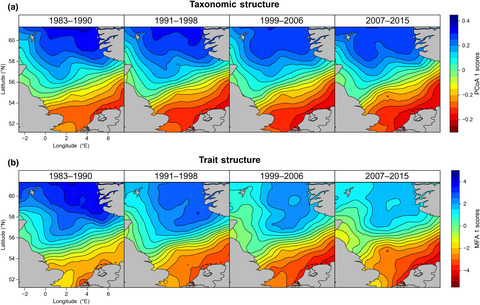
We compared the spatio-temporal dynamics of species and trait structure in North Sea fish communities over 33 years. Both species and trait structure changed significantly over time; however, communities in the southern and northern North Sea diverged towards different species, becoming taxonomically more dissimilar over time, yet they converged towards the same traits regardless of species differences. In particular, communities shifted towards smaller, faster growing species with higher thermal preferences and pelagic water column position. Our findings suggest that global environmental change, notably climate warming, will lead to convergence towards traits more adapted for novel environments regardless of species composition.
TECHNICAL ADVANCE
Fixing a snag in carbon emissions estimates from wildfires
- Pages: 3985-3994
- First Published: 30 May 2019
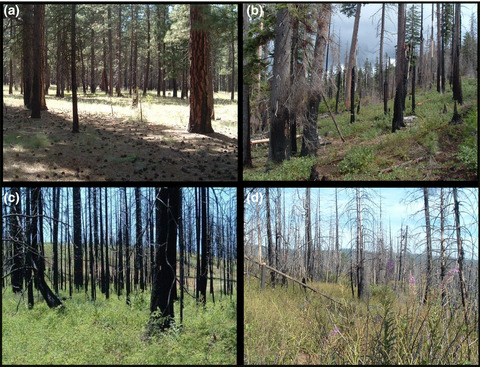
Emissions from forest fires in the western United States are often vastly overestimated due to the misconception that mature forests can “burn to the ground.” In fact, the largest pool of aboveground carbon in western US forests—live, mature trees—negligibly combusts during fire and remains as standing, dead stems for years to centuries. Using realistic combustion coefficients from new field observations and an improved ecosystem model that represents dead, standing trees, we demonstrate that model simulations can double realistic fire-event emissions estimates in the western United States by assuming 30%–80% live tree combustion, with overestimates increasing in carbon-dense forests.




